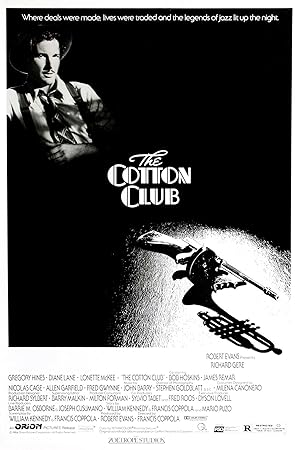The Cotton Club
| 1984Directed by: Francis Ford Coppola

Main Plot
The Cotton Club is set in the 1920s and revolves around the famous Harlem nightclub of the same name, which serves as a backdrop for the intertwining lives of its patrons and performers. The story follows a young white musician who becomes involved with the club, navigating the vibrant yet dangerous world of jazz, crime, and racial tensions. As he rises in the music scene, he encounters various characters, including African American performers who struggle for recognition and respect in a segregated society. The narrative explores themes of ambition, loyalty, and the complexities of race relations, all while showcasing the rich cultural atmosphere of the era. The Cotton Club serves as a stage for both the glamour of the jazz age and the darker realities of organized crime, ultimately highlighting the challenges faced by those who seek to break barriers in pursuit of their dreams.
Characters
- Richard Gere plays Dixie Dwyer, a trumpeter who becomes entangled with mobsters and a love interest, influencing his life and career during the Harlem Renaissance.
- Gregory Hines plays Sandman Williams, a talented tap dancer navigating love and ambition in a Harlem jazz club during the Prohibition era.
- Diane Lane plays Vera Cicero, a glamorous jazz singer and love interest of the protagonist, contributing to the intertwining relationships and tensions in the story.
Ending Explained
In the ending of The Cotton Club, the narrative culminates in a blend of personal and societal conflicts that reflect the complexities of the era. The film, set during the Prohibition era, follows the intertwined lives of musicians, gangsters, and performers in a famous Harlem nightclub. As tensions rise, the main characters face the consequences of their choices against the backdrop of racial discrimination and organized crime. The climax occurs when the protagonist, who has been navigating the dangerous world of the club and its connections to the mob, must confront the reality of his situation. The violence and betrayal that have been simmering throughout the film come to a head, leading to a tragic confrontation. This moment serves as a turning point, highlighting the harsh realities of ambition and the cost of loyalty in a world rife with corruption. In the resolution, the characters are left to reckon with their fates. The Cotton Club itself symbolizes both the allure and the peril of the jazz age, and the ending reinforces the idea that dreams can be both beautiful and destructive. Ultimately, the film closes on a note of bittersweet reflection, encapsulating the struggles of its characters within the broader context of American history.